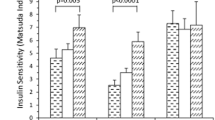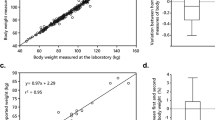Abstract
Purpose
To examine the association between insulin sensitivity and adiposity in children stratified according to their body mass index (BMI: normal weight, NW; overweight or obese, OW/OB) and body-fat percentage (BF%: adipose or NonAdipose), and determine whether cardiorespiratory fitness (CRF) ameliorates any deleterious associations.
Methods
This prospective cohort study comprises a cross-sectional and longitudinal analyses of data collected at baseline and 2 years later on children (7.7–13.4 years) attending public school in Denmark. Levels of CRF were measured using the Andersen test, whereas BF% was measured by dual-energy X-ray absorptiometry (DXA). Fasting plasma glucose and insulin concentrations were measured and the homoeostatic model assessment of insulin resistance (HOMA-IR) used to assess insulin sensitivity.
Results
Approximately 8% of children classified as normal weight by BMI had high BF% (NW + Adipose). Children with high BF% had significantly higher insulin (NW + adipose: 32.3%; OW/OB + Adipose: 52.2%) and HOMA-IR scores (NW + Adipose: 32.3%; OW/OB + Adipose: 55.3%) than children classified as NW without high BF% (reference group; NW + NonAdipose). Adjusting for CRF reduced this difference, but did not completely ameliorate these associations. Longitudinally, children with high BF% (OW/OB + Adipose or NW + Adipose) had significantly worse insulin sensitivity 2 years later than NW + NonAdipose children (All p < 0.001). The few children (n = 14) who improved their BMI or BF% during the 2 years follow-up, no longer had significantly worse insulin sensitivity than children with NW + NonAdipose.
Conclusion
High BF% in children is associated with significantly lower insulin sensitivity even when BMI is considered NW. Longitudinally, insulin sensitivity is lower in children with high BF% with or without high BMI. The CRF was a significant covariate in these models, but CRF did not completely ameliorate the effects of high BF% on insulin sensitivity.
This is a preview of subscription content, access via your institution
Access options
Subscribe to this journal
Receive 12 print issues and online access
$259.00 per year
only $21.58 per issue
Buy this article
- Purchase on Springer Link
- Instant access to full article PDF
Prices may be subject to local taxes which are calculated during checkout



Similar content being viewed by others
References
Ferrannini E, Natali A, Bell P, Cavallo-Perin P, Lalic N, Mingrone G. Insulin resistance and hypersecretion in obesity. European Group for the Study of Insulin Resistance (EGIR). J Clin Invest. 1997;100:1166–73.
Sinaiko AR, Jacobs DR Jr., Steinberger J, Moran A, Luepker R, Rocchini AP, et al. Insulin resistance syndrome in childhood: associations of the euglycemic insulin clamp and fasting insulin with fatness and other risk factors. J Pediatr. 2001;139:700–7.
Weiss R, Dziura J, Burgert TS, Tamborlane WV, Taksali SE, Yeckel CW, et al. Obesity and the metabolic syndrome in children and adolescents. New Engl J Med. 2004;350:2362–74.
Sinaiko AR, Steinberger J, Moran A, Prineas RJ, Vessby B, Basu S, et al. Relation of body mass index and insulin resistance to cardiovascular risk factors, inflammatory factors, and oxidative stress during adolescence. Circulation. 2005;111:1985–91.
Bao WH, Srinivasan SR, Berenson GS. Persistent elevation of plasma insulin levels is associated with increased cardiovascular risk in children and young adults—The Bogalusa Heart Study. Circulation. 1996;93:54–9.
Dabelea D, Mayer-Davis EJ, Saydah S, Imperatore G, Linder B, Divers J, et al. Prevalence of type 1 and type 2 diabetes among children and adolescents from 2001 to 2009. J Am Med Assoc. 2014;311:1778–86.
Mizokami-Stout K, Cree-Green M, Nadeau KJ. Insulin resistance in type 2 diabetic youth. Curr Opin Endocrinol Diabetes Obes. 2012;19:255–62.
D’Adamo E, Caprio S. Type 2 diabetes in youth: epidemiology and pathophysiology. Diabetes Care. 2011;34:S161–S5.
Rhodes ET, Prosser LA, Hoerger TJ, Lieu T, Ludwig DS, Laffel LM. Estimated morbidity and mortality in adolescents and young adults diagnosed with type 2 diabetes mellitus. Diabet Med. 2012;29:453–63.
Schmitz KH, Jacobs DR, Hong CP, Steinberger J, Moran A, Sinaiko AR. Association of physical activity with insulin sensitivity in children. Int J Obes. 2002;26:1310–6.
Bell LM, Watts K, Siafarikas A, Thompson A, Ratnam N, Bulsara M, et al. Exercise alone reduces insulin resistance in obese children independently of changes in body composition. J Clin Endocr Metab. 2007;92:4230–5.
Brouwer SI, Stolk RP, Liem ET, Lemmink KA, Corpeleijn E. The role of fitness in the association between fatness and cardiometabolic risk from childhood to adolescence. Pediatr Diabetes. 2013;14:57–65.
Levy-Marchal C, Arslanian S, Cutfield W, Sinaiko A, Druet C, Marcovecchio ML, et al. Insulin resistance in children: consensus, perspective, and future directions. J Clin Endocr Metab. 2010;95:5189–98.
Allen DB, Nemeth BA, Clark RR, Peterson SE, Eickhoff J, Carrel AL. Fitness is a stronger predictor of fasting insulin levels than fatness in overweight male middle-school children. J Pediatr. 2007;150:383–7.
Wells JC. Toward body composition reference data for infants, children, and adolescents. Adv Nutr. 2014;5:320S–9S.
Fairchild TJ, Klakk H, Heidemann MS, Andersen LB, Wedderkopp N. Exploring the relationship between adiposity and fitness in young children. Med Sci Sports Exerc. 2016;48:1708–14.
Wedderkopp N, Jespersen E, Franz C, Klakk H, Heidemann M, Christiansen C, et al. Study protocol. The Childhood Health, Activity, and Motor Performance School Study Denmark (The CHAMPS-study DK). BMC Pediatr. 2012;12:128.
Andersen LB, Andersen TE, Andersen E, Anderssen SA. An intermittent running test to estimate maximal oxygen uptake: the Andersen test. J Sports Med Phys Fitnes. 2008;48:434–7.
Ahler T, Bendiksen M, Krustrup P, Wedderkopp N. Aerobic fitness testing in 6- to 9-year-old children: reliability and validity of a modified Yo-Yo IR1 test and the Andersen test. Eur J Appl Physiol. 2012;112:871–6.
Cole TJ, Bellizzi MC, Flegal KM, Dietz WH. Establishing a standard definition for child overweight and obesity worldwide: international survey. BMJ. 2000;320:1240–3.
Williams DP, Going SB, Lohman TG, Harsha DW, Srinivasan SR, Webber LS, et al. Body fatness and risk for elevated blood-pressure, total cholesterol, and serum-lipoprotein ratios in children and adolescents. Am J Public Health. 1992;82:358–63.
Matthews DR, Hosker JP, Rudenski AS, Naylor BA, Treacher DF, Turner RC. Homeostasis model assessment: insulin resistance and beta-cell function from fasting plasma glucose and insulin concentrations in man. Diabetologia. 1985;28:412–9.
Bonora E, Kiechl S, Willeit J, Oberhollenzer F, Egger G, Meigs JB, et al. Insulin resistance as estimated by homeostasis model assessment predicts incident symptomatic cardiovascular disease in caucasian subjects from the general population: the Bruneck study. Diabetes Care. 2007;30:318–24.
Wallace TM, Levy JC, Matthews DR. Use and abuse of HOMA modeling. Diabetes care. 2004;27:1487–95.
Tanner JM. Growth at adolescence: with a general consideration of the effects of hereditary and environmental factors upon growth and maturation from birth to maturity. Oxford: Blackwell Scientific Publications; 1962.
Rasmussen AR, Wohlfahrt-Veje C, de Renzy-Martin KT, Hagen CP, Tinggaard J, Mouritsen A, et al. Validity of self-assessment of pubertal maturation. Pediatrics. 2015;135:86–93.
Zeger SL, Liang KY, Albert PS. Models for longitudinal data: a generalized estimating equation approach. Biometrics. 1988;44:1049–60.
Zorn CJW. Generalized estimating equation models for correlated data: a review with applications. Am J Polit Sci. 2001;45:470–90.
Klakk H, Grontved A, Moller NC, Heidemann M, Andersen LB, Wedderkopp N. Prospective association of adiposity and cardiorespiratory fitness with cardiovascular risk factors in healthy children. Scand J Med Sci Sports. 2014;24:e275–e82.
Lee DC, Sui XM, Church TS, Lee IM, Blair SN. Associations of cardiorespiratory fitness and obesity with risks of impaired fasting glucose and type 2 diabetes in men. Diabetes Care. 2009;32:257–62.
Andersen LB, Lauersen JB, Brond JC, Anderssen SA, Sardinha LB, Steene-Johannessen J, et al. A new approach to define and diagnose cardiometabolic disorder in children. J Diabetes Res. 2015;2015:539835.
Parrett AL, Valentine RJ, Arngrimsson SA, Castelli DM, Evans EM. Adiposity and aerobic fitness are associated with metabolic disease risk in children. Appl Physiol Nutr Metab. 2011;36:72–9.
Acknowledgements
We gratefully acknowledge the work of numerous research staff and PhD students who have participated in the data collection for the CHAMPS study-DK. We thank children, parents and teachers in the schools involved in the project, and we are grateful for the cooperation with the Svendborg Project, Sport Study Sydfyn and the municipality of Svendborg.
Funding
Funding for the study has been provided by The TRYG Foundation, University College Lillebaelt, University of Southern Denmark, The Nordea Foundation, The IMK Foundation, The Region of Southern Denmark, The Egmont Foundation, The A.J. Andersen Foundation, The Danish Rheumatism Association, Østifternes Foundation, Brd. Hartmann’s Foundation, TEAM Denmark, The Danish Chiropractor Foundation, and The Nordic Institute of Chiropractic and Clinical Biomechanics. Finally, the authors wish to acknowledge the members of the CHAMPS study-DK not listed as coauthors of this paper: C. T. Rexen, E. Jespersen, NC Moller and C. Franz.
Author information
Authors and Affiliations
Corresponding author
Ethics declarations
Conflict of interest
The authors declare that they have no conflict of interest.
Rights and permissions
About this article
Cite this article
Fairchild, T.J., Klakk, H., Heidemann, M. et al. Insulin sensitivity is reduced in children with high body-fat regardless of BMI. Int J Obes 42, 985–994 (2018). https://doi.org/10.1038/s41366-018-0043-z
Received:
Revised:
Accepted:
Published:
Issue Date:
DOI: https://doi.org/10.1038/s41366-018-0043-z
This article is cited by
-
Is cardiorespiratory fitness a moderator of the relationship between sugar-sweetened beverage consumption and insulin resistance in schoolchildren?
European Journal of Nutrition (2023)



